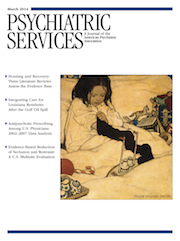Multisite Study of an Evidence-Based Practice to Reduce Seclusion and Restraint in Psychiatric Inpatient Facilities
Abstract
Objective
This federally funded study examined implementation and outcomes of the Six Core Strategies for Reduction of Seclusion and Restraint (6CS) in 43 inpatient psychiatric facilities.
Methods
A prototype Inventory of Seclusion and Restraint Reduction Interventions (ISRRI) tracked fidelity over time. Outcome measures—seclusion and restraint events as percentages of total inpatient population and seclusion and restraint hours as percentages of total inpatient hours—conformed to licensed Behavioral Health Performance Measurement System specifications. Independent variables were facility and patient characteristics. Facilities were classified into five implementation types based on ISRRI scores: stabilized (N=28), continued (N=7), decreased (N=5), discontinued (N=1), or never implemented (N=2). For the stabilized group, linear modeling and random-effects meta-analysis compared the contribution of individual facilities to an overall effect. Subgroup analyses explored relationships between facility characteristics and outcomes. Dose-effect analysis tested the hypothesis that the stabilized group would have more positive outcomes.
Results
Overall, the stabilized group reduced the percentage secluded by 17% (p=.002), seclusion hours by 19% (p=.001), and proportion restrained by 30% (p=.03). The reduction in restraint hours was 55% but nonsignificant (p=.08). Individual facility effect sizes varied; some rates increased for some facilities. The dose-effect hypothesis was supported for two outcomes, seclusion hours and percentage restrained. The order of implementation group effects in relation to each outcome varied unpredictably.
Conclusions
The 6CS was feasible to implement and effective in diverse facility types. Fidelity over time was nonlinear and varied among facilities. Further research on relationships between facility characteristics, fidelity patterns, and outcomes is needed.



